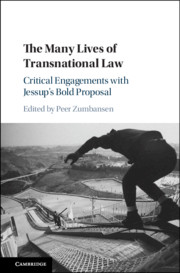Book contents
- Reviews
- The Many Lives of Transnational Law
- The Many Lives of Transnational Law
- Copyright page
- Contents
- Contributors
- Preface and Acknowledgements
- Introduction Transnational Law, with and beyond Jessup
- Part I Transnational Law
- 1 Jessup at the United Nations
- 2 The Concept of a Global Legal System
- 3 How Comity Makes Transnationalism Work
- Part II Transnational Law as Regulatory Governance
- Part III Transnational Law
- Part IV Conclusion
- Index of Names
- Subject Index
2 - The Concept of a Global Legal System
from Part I - Transnational Law
Published online by Cambridge University Press: 18 March 2020
- Reviews
- The Many Lives of Transnational Law
- The Many Lives of Transnational Law
- Copyright page
- Contents
- Contributors
- Preface and Acknowledgements
- Introduction Transnational Law, with and beyond Jessup
- Part I Transnational Law
- 1 Jessup at the United Nations
- 2 The Concept of a Global Legal System
- 3 How Comity Makes Transnationalism Work
- Part II Transnational Law as Regulatory Governance
- Part III Transnational Law
- Part IV Conclusion
- Index of Names
- Subject Index
Summary
An enduring contribution of Jessup’s Transnational Law is his critique of “international law” and his case for a functionalist concept of “transnational law” defined as rules—international, national or private—that offer solutions to transnational problems. Extending Jessup’s argument, this chapter critiques the concept of the “international legal system,” proposes an alternative concept of the “global legal system” and offers an analytical framework for understanding that system. The global legal system consists of not only rules, but also courts and other institutions, that provide legal solutions to transnational problems. These institutions are national, international, private and sometimes hybrid. Among the solutions provided are three generic governance functions: prescription, adjudication and enforcement. More than one institution may provide solutions to a given transnational problem, creating a need for choice across three dimensions: national-national, national-international and public-private. The global legal system uses three types of principles to guide these choices: principles of authority, allocation and party autonomy. This chapter’s concept of a global legal system aims to provide a coherent way of thinking about the multiple transnational problem-solving functions of legal systems and the multiple levels at which those functions are performed.
Keywords
- Type
- Chapter
- Information
- The Many Lives of Transnational LawCritical Engagements with Jessup's Bold Proposal, pp. 72 - 87Publisher: Cambridge University PressPrint publication year: 2020



